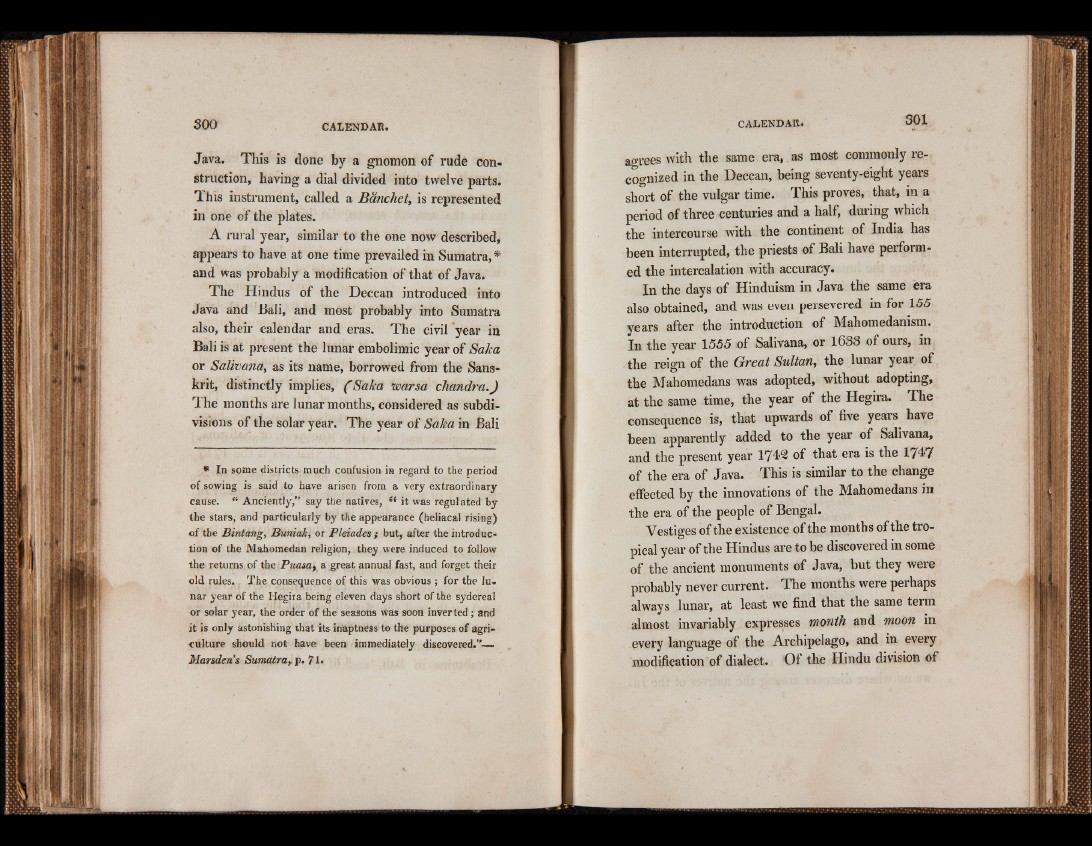
Java. This is done by a gnomon of rude construction,
having a dial divided into twelve parts.
This instrument, called a Banchet, is represented
in one of the plates.
A rural year, similar to the one now described,
appears to have at one time prevailed in Sumatra,*
and was probably a modification of that of Java.
The Hindus of the Deccan introduced into
Java and Bali, and most probably into Sumatra
also, their calendar and eras. The civil year in
Bali is at present the lunar embolimic year of Saka
or Salivana, as its name, borrowed from the Sanskrit,
distinctly implies, ( Saka warsa chandra.)
The months are lunar months, considered as subdivisions
of the solar year. The year of Saka in Bali
* In some districts much confusion in regard to the period
of sowing is said to have arisen from a very extraordinary
cause. “ Anciently,” say the natives, e< it was regulated by
the stars, and particularly by the appearance (heliacal rising)
of the Bintang, Buniak, or Pleiades ; but, after the introduction
of the Mahomedan religion, they were induced to follow
the returns of the Puasay a great annual fast, and forget their
old rules., The consequence of this was obvious; for the lunar
year of the Hegira being eleven days short of the sydereal
or solar year, the order of the seasons was soon inverted; and
it is only astonishing that its inaptness to the purposes of agriculture
should not have been immediately discovered.”—
Marsden’s Sumatrar p. 7 %•
agrees with the same era, as most commonly recognized
in the Deccan, being seventy-eight years
short of the vulgar time. This proves, that, in a
period of three centuries and a half, during which
the intercourse with the continent of India has
been interrupted, the priests of Bali have performed
the intercalation with accuracy.
In the days of Hinduism in Java the same era
also obtained, and was even persevered in for 155
years after the introduction of Mahomedanism.
In the year 1555 of Salivana, or 1633 of ours, in
the reign of the Great Sultan, the lunar year of
the Mahomedans was adopted, without adopting,
at the same time, the year of the Hegira. The
consequence is, that upwards of five years have
been apparently added to the year of Salivana,
and the present year 1742 of that eia is the 1747
of the era of Java. This is similar to the change
effected by the innovations of the Mahomedans in
the era of the people of Bengal.
Vestiges of the existence of the months of the tropical
year of the Hindus are to be discovered in some
of the ancient monuments of Java, but they were
probably never current. The months were perhaps
always lunar, at least we find that the same term
almost invariably expresses month and moon in
every language of the Archipelago, and in every
modification of dialect. Of the Hindu division of